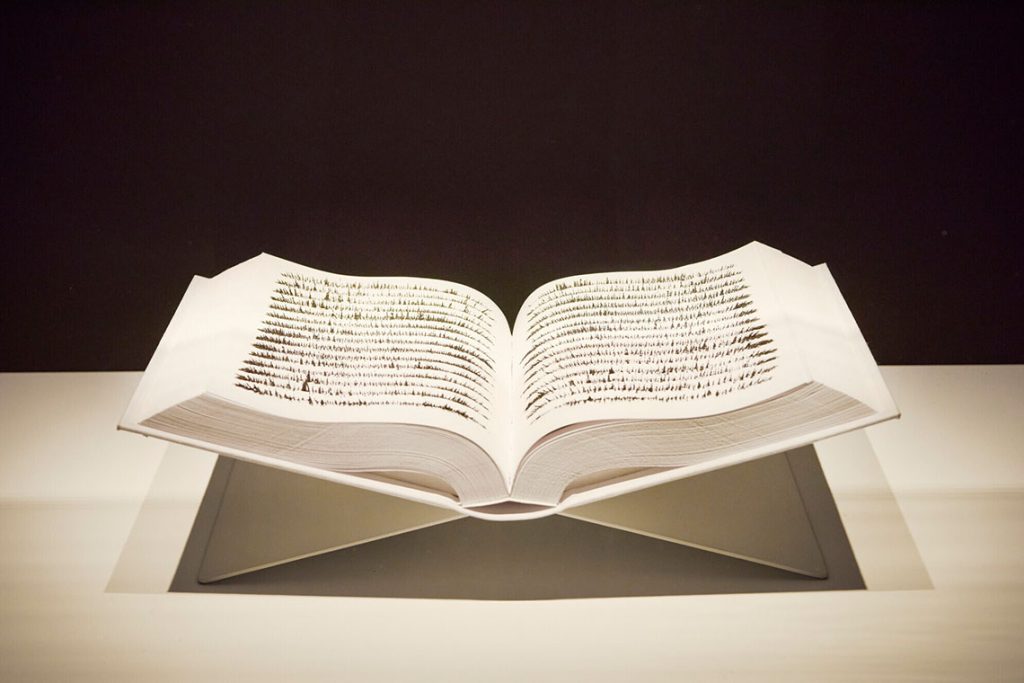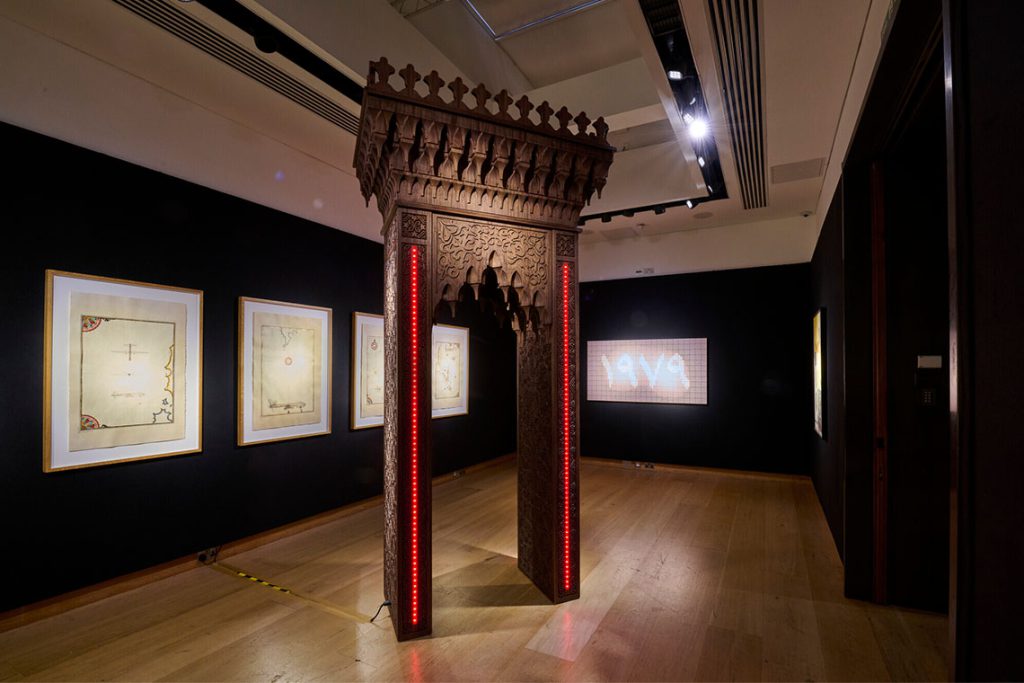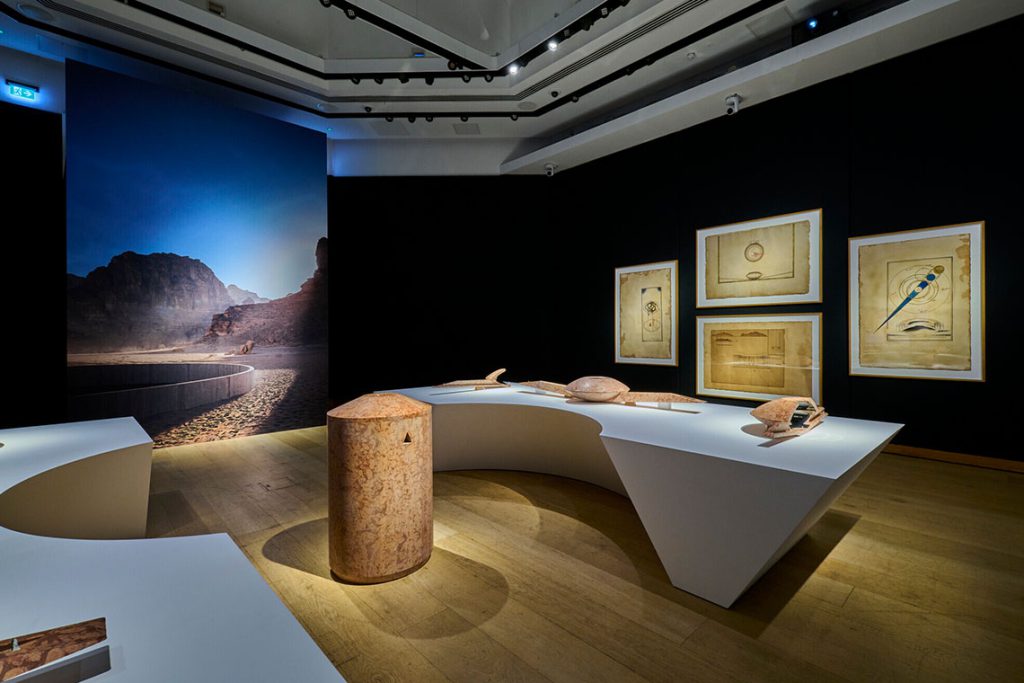A series of unconventional exhibition choices lend further depth to the flawless visuals and intriguing concepts which make up the Ahmed Mater: Chronicles.
There is a kind of quiet self-assurance to Ahmed Mater’s mid-career retrospective exhibition at Christie’s in London. Of course, the renowned auction house is no stranger to putting on a show, and Ahmed Mater is already a highly respected artist with an established career. However, these elements alone are not enough to pull off a large solo exhibition by an Arab artist in the British capital, in which artists from the Middle East have not always been given the attention they arguably deserve by institutions such as Christie’s.
This is where Ridha Moumni, curator of the exhibition and chairman of Christie’s Middle East & Africa, steps in. The capacity of Moumni and his team to bring art from the region to the auction house was put to the test with last year’s Kawkaba: Highlights from the Barjeel Art Foundation, a combined effort with Sultan Sooud El Qassemi, the founder of the Barjeel Art Foundation, to host the largest exhibition yet of Arab art in London. It was a resounding success, and no doubt paved the way for the current Ahmed Mater: Chronicles exhibition.

Image courtesy of private collection and Christie’s Images Ltd 2024
There is a palpably different atmosphere from usual in the Christie’s lobby, and it feels like something more than just the buzz of excitement surrounding a new show. Ahmed Mater’s work is displayed over two floors, with the ground floor housing the artist’s older work, and the first floor displaying his more recent pieces. It is immediately apparent that the emphasis is on the upstairs section, where the plans for Mater’s upcoming land art installation in Wadi AlFann in the AlUla desert are presented in the UK for the first time. Yet downstairs there is also much of interest, not least a room housing not only one of Mater’s first paintings, a charming depiction of his home village, but also dedicated to his artistic influences, among them his mother, Fatimah Hassan Abdullah, an artist in her own right. This space sets a refreshingly different tone from the stardom usually associated with an artist like Mater.
That said, the ground-floor space is also home to some of Mater’s celebrated showstoppers, including the cool-toned blue against black display of his famed Evolution of Man (2010) series. The impact of his medical training and his artful journeys of experimentation saw him combine the highly modern iconography of the X-ray with traditional Islamic art elements such as script and gold leaf in Talisman X-Ray Blue (Torso) (2009) and Illumination IX & X (diptych) (2009).

Image courtesy of the artist and Christie’s Images Ltd 2024
In Mater’s later work, upstairs, and in the main exhibition room, there is an almost intoxicating feeling. Something about the lighting, and standing in front of Mater’s famous Lightning Lzand (2017) image, seems to bounce the electric atmosphere back to the viewer, in contrast with the stillness of Gas Station (2013). One of the primary aims of Mater has always been to reveal a different side to his home country of Saudi Arabia, and – as he explains in a short video introduction to the exhibition – demonstrate that the Kingdom has much more to it than just oil.
Another of Mater’s most iconic works, Magnetism (2009), is also here, with its delicate iron filings galvanised full of motion, alongside the new Magnetism Book (2024). Their juxtaposition with Boundary (2024), a hand-carved wooden ‘gate’ designed to look like the mihrab in a mosque and which lights up and beeps like an airport security gate, is an interesting reflection on the nature of crowds and mass movement.
On either side of the doorway before Boundary hang two beautiful gold-leaf laced artworks, depicting sketches of satellites to signify the entry into a ‘surveillance zone’ in this room. This attention to detail, as well as each space seemingly reflecting the artwork it holds felt especially intentional, while leaving room for the viewer to independently unearth certain thematic clues along the way.

Another example of this is one slightly overcrowded room, with works such as Human Highway (2012) and Walkway to Mina (2012), along with other photographs and objects which hold special meaning to the artist. The difficulty of selecting from a huge range of excellent work is apparent, but here the weight of the overcrowded space fits with the images of highways opaque with people to the point it seems the elevated road might collapse.
Of course, a visit to this show is designed to culminate in Mater’s upcoming project for Wadi AlFann, Ashab Al-Lal, of which we are shown maquette sculptures, illustrations called Illuminations and studies in a preview of the upcoming site-specific installation. Although the project is a fascinating continuation of his artistic experiments, this time on a massive scale, it is not perhaps where the heart of the exhibition lies. This is rather more a deeply moving portrayal of a complex country through the eyes of an artist who finds great strength and inspiration in all the things that have shaped his journey. Each room of the exhibition is a little world unto itself, reflecting the diversity of Mater’s practice and with particular care taken over the viewer’s experience via an immersive quality not always present in institutional shows, particularly at auction houses.
A surprising yet enjoyable addition to the exhibition is a corridor off the main room which houses a series of stained-glass windows, too many to fit in the main exhibition rooms. Curator Ridha Moumni confesses he found them beautiful and simply wanted to give them a home in the show. It’s a quirky and rather sentimental decision, but somehow gives this exhibition an additional authentic and honest edge, perhaps one that its main protagonist would welcome as an artist who has never shied away from making his mark and deviating from the traditional path.



